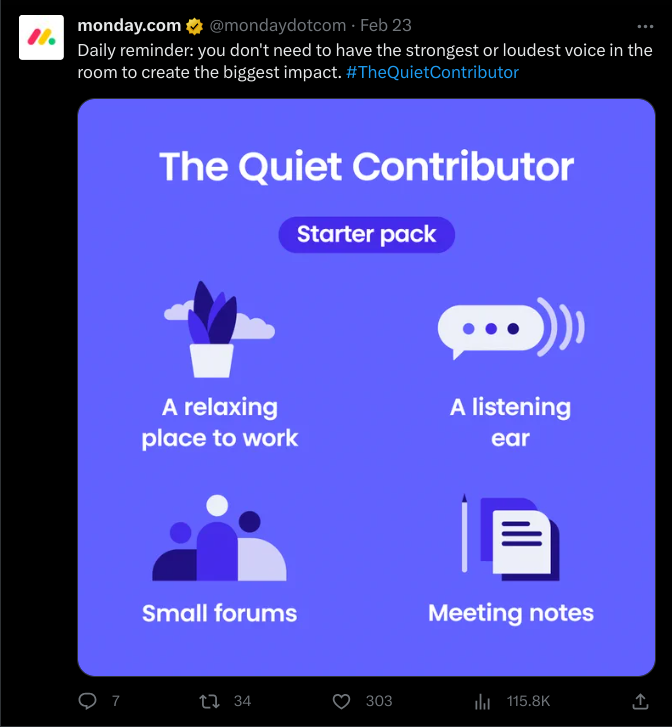B2B brands have the opportunity to leverage content marketing as a way of reaching their target audience and gaining new customers. But it’s not as simple as writing a few blog posts, posting them on your website and hoping for the best.
A content marketing strategy is essential to gaining leads, positioning your brand as a resource for your audience in the industry and nurturing your prospects before — and long after — they become customers.
HubSpot’s 2023 State of Content Marketing survey found that B2B content marketers are doing more than just blogging to boost their strategy; they’re using more social media, producing short-form video content as often as possible and making SEO a must-have to attract and convert leads.
If you’re interested in building an effective B2B content marketing strategy but you’re not quite sure where to get started, we can help. We’ve created a guide to help you get started and curate content that helps with lead generation, cultivating a loyal audience and building revenue.
Don’t Have a Content Strategy Yet?
B2B marketing is meant to help audiences become more aware of your brand and remain engaged throughout the sales cycle. With the right strategy, you can plan out how to support a new product or service, or speak on something important happening in the industry.
In addition, a content plan can help you measure how successful your efforts have been so far.
If you’re not sure if a content marketing plan is right for your business, consider what would happen if you didn’t have a marketing strategy at all. How would you know which products were succeeding and which were not? How would a new prospect get to know your brand? Imagine what could happen if you boosted all of your advertisements with content to build a more effective campaign.
No matter what industry you serve, gaining leads and closing deals is every business’ goal. Content marketing can deliver high ROI because of its relatively low cost and long-term effect. Quality, focused content can continue to deliver high value for years after it’s been published.
If you’re new to content marketing, we’ll dive into how to build a strategy. But, the benefits are nearly endless if you put together the right plan:
- Boost brand awareness.
- Gain an edge over competitors.
- Establish your brand as an authority in the industry.
- Rank on search engine results pages (SEPs).
- Get shares on social media.
- Earn backlinks that can drive more traffic and boost SEO.
- Educate your audience on subjects they’re interested in.
- Give a voice to your brand and something customers can connect with.
- Develop long-term relationships with customers.
B2B Content Marketing: What Makes It Unique?
Before you can get started with content marketing, it’s important to understand how it comes into play from a B2B perspective.
B2B marketing derives from a strategy or content that is made specifically for a business. Typically, this refers to an organization that sells some type of product or service to other companies. In comparison, B2C marketing works for companies that are targeting individual consumers who are making purchases for themselves.
Goals for B2B marketing vs B2C marketing differ greatly, as HubSpot explained in this example:
- In B2B marketing, customers want ROI and expertise. When it comes to B2C content, customers want deals and entertainment. That means the latter needs to be more fun, and the former needs to be more educational and logical.
If you’re a B2B company and you’re putting all of your focus on advertising, now’s a good time to consider adding creative content to your collateral. According to Demand Metric, 70% of people would prefer to learn about a company through content like a blog post or article in comparison to a typical advertisement.
What this means is that in B2B content, instead of keeping up with the latest TikTok trends, B2B marketing should focus more on assets like:
- eBooks.
- Blogs.
- Short-from informational videos.
- Applications.
- Email and direct mail.
- Surveys and reports.
- White papers.
- One pagers.
- Infographics.
- Podcasts.
B2B marketing doesn’t have to be boring, it just has to be direct and offer informational value to its audience, rather than just entertain them. Think of Wendy’s Twitter posts versus Monday.com.


See the difference? B2B content can be personable, but it typically isn’t as pointed or has the space to be as spicy as B2C.
If you’re a B2B company and you’re putting all of your focus on advertising, now’s a good time to consider adding creative content to your collateral. Semrush notes that 44% of their 2023 Global Report respondents said quality content that adds value to their readers’ lives led to more success.
Creating Your B2B Content Marketing Strategy: 10 Steps to Success
So maybe you’re on board with the idea of content marketing, but you’re not sure where to get started. Don’t fret—we’ve created a step-by-step guide to creating a B2B content marketing strategy and executing it properly:
Subscribe to
The Content Marketer
Get weekly insights, advice and opinions about all things digital marketing.
Thank you for subscribing to The Content Marketer!
1. Define Your Overall Goals
Your content marketing strategy should be built with purpose. Setting goals and key performance indicators (KPIs) in the early stages can help you bring your business to life. We recommend following the SMART process when coming up with your goals:
- Specific: Don’t be broad, hone in on exactly what it is you want to achieve.
- Measurable: What does your business’ success mean to you, and how will this motivate you to move forward?
- Achievable: Are there going to be blockades keeping you from achieving your goals, or are they truly attainable?
- Relevant: Your goals should not only be realistic but make sense regarding your business strategy.
- Time-bound: How long is it going to take to achieve your goals, and does this timeline work for you?
Using these criteria as the blueprint for your content marketing strategy can make it easier to envision the bigger picture during the beginning stages of the process.
2. Understand Your Audience and Create Buyer Personas
Who are you creating content for? How are you going to resonate with your target audience? What does your potential buyer want to get out of visiting your website?
Getting to know the individuals who are paying close attention to you, your products and services all start with creating a buyer persona. Essentially, a buyer persona is a fictional character that performs as a person who would be interested in your product.
This fictional representation is curated by market research and data collected about your customers in an effort to create as real of a person in this scenario as you possibly can. Individual buyer personas should include demographic information, job role, as well as specific goals and challenges this decision-maker faces.
Creating buyer personas will give you a better idea of how to create your message and who you need to tailor it to. Dive into which channels they engage with the most, where they spend their time online and what types of content resonate with them.

3. Create a Brand Voice
Does your brand have a certain style that sets you apart from your competitors? Creating a distinct voice and tone will give you the leverage to stand out in your industry.
Decide what your brand’s personality will be in written form, whether it’s educational and serious or humorous and relatable. Tone is something that offers more flexibility, as it can be used in content based on specific buyer personas and the medium they’re reading in.
Think about it this way: Your tone isn’t going to be the same in a short blurb as it would be in a white paper. Consider how you speak to prospective customers in the early stages versus your follow-up collateral after they’ve made a purchase.
4. Map Out the Customer Journey
Now that you’ve established a strong foundation for your brand in general, it’s time to think about how you’ll leverage your company to bring in customers through the sales funnel. This takes place after putting forth lead generation efforts; it’s where your potential customers start at the top and come out as loyal clients. Also known as a marketing funnel, this is where your customers start their journey with you and are welcome to explore what your business has to offer. As they get to the middle, you nurture them and guide them toward the bottom where they can start the beginning stages of a sale.
The sales funnel isn’t a one-size-fits-all template. In fact, we put together a list of different examples to consider for your own business. Take a look and decide which makes the most sense for your content marketing strategy.
5. Understand What Your Competitors are Doing
While most of your focus should be on bringing customers in, you still need to pay attention to your competitors. With a strong understanding of what they’re doing, you can identify gaps in the industry and learn how to better serve your customers.
A simple way to do this is by benchmarking or tracking your KPIs along the way. Consider which metrics will indicate that your content marketing is a success such as shares, time on the page and SERP ranking. This gives you an inside look at what’s working for them and what isn’t, which can give you the upper hand to better define the industry standard.
6. Brainstorm with Your Content Team
With the backend research in the palm of your hand, it’s time to get together with your team of content creators and assess the content types you want to move forward with. Brainstorming sessions can come in handy when it comes to collaboration among a content team.
Gather which keywords and phrases are performing well in the industry, and which ones will be more achievable (because a Google SERP feature can be tricky). Of these keywords, what types of content would best serve them? Then, decide when you will post each piece of content, where the content will live and how it will be distributed using a content calendar. Developing these details ahead of time will help make the marketing team’s job easier in the long run.
7. Create a Content Strategy Blueprint
After brainstorming with the team of creators, it’s time to move forward with your specific content types. It’s important to be flexible throughout your strategy, however—down the line, you may find that a content audit and ROI show one content format is producing better results for you than another, which can ultimately guide the future of your process. Having a flexible blueprint will keep you organized and prepared to navigate a different route if necessary.
Content types to consider include:
- Blogs.
- Whitepapers.
- eBooks.
- Case studies.
- Infographics.
- Newsletters.
- Press releases.
- Webinars.
Remember: Your content marketing plan can change over time; limiting yourself to only a few different content formats could hold you back from reaching your goals. Consider having these content types in rotation in a content calendar over a certain period of time if you want to explore the different opportunities of each option.
8. Execute Your Strategy and Start Creating Content
Now that your complete strategy is in writing, it’s time to bring your content marketing efforts to fruition. By now, you’re ready to take those content ideas and bring them to life. While content creation itself can be a strenuous task, it can also be considered the light at the end of the tunnel in terms of your content marketing strategy.
It’s where all of your hard work is put to the test: Did you properly educate your team on buyer personas? Was your keyword research and topic selection on point? All of these questions will be answered in the coming months after putting your content out there, but first, you need to put the pen to paper (or, fingertips to keyboard) and get to work!
9. Promote Your Content
Once your content is squeaky clean, keyword-targeted and ready for your target audience, it’s time to publish and promote. This can involve sending out an email blast, posting to social media, or creating targeted ads to get more eyes on your content. How you choose to promote your content should align with your specific goals of the strategy, but the more eyes on your work, the better!
10. Measure the ROI
Now, it’s time to see if your quality content performed as well as planned. The final stage of your content marketing strategy should involve a content performance check or a content audit to measure the ROI and effectiveness of your content creation process.
In content marketing, ROI shows how much revenue was gained after executing your digital marketing plan in comparison to the amount of money that was spent during the strategy and creation phases. Measuring ROI over a lengthy period of time can be difficult, but it can be simplified by measuring metrics every couple of months to determine if you created engaging content that’s reaching your target audience. We recommend tracking metrics such as:
- Website traffic.
- CTA click-through rates.
- Keyword rankings.
- Conversion rates.
- Shares on social media platforms.
11. Create Templates for Content Types
Streamlining your content creation and execution can help ensure you don’t lose steam over time, and that each piece your teams create is consistent across the board. The best way to do this is by establishing templates for content types.
For example, blogs are fairly organic, you want to make sure you have your brand name at the top of each page and each piece follows a similar flow. eBooks, white papers, infographics and social media calendars should all be templated, though with word count limitations and heading formatting.
12. Work with Professional Content Marketers
If content planning, writing, tracking and marketing isn’t really the core skill of your business, you could leave it up to professionals who specialize in content creation.
If you’re considering this route, make sure to find a content marketing company that will go above and beyond to get to know your brand. Get an understanding of what they have to offer, ask for samples of writing, video and animation, and speak with the content creators themselves if possible. Oh, and don’t forget to browse their website for case studies, testimonials and success stories to seal the deal (hint hint, click the link!)
Digiday’s research found that 75% of its survey respondents use freelancers from content marketplaces.
 How to Tell if Your Content Marketing Strategy is Working
How to Tell if Your Content Marketing Strategy is Working
Measuring your ROI comes in many different forms, as we detail above. But one of the most important aspects many tend to overlook is maintaining your content strategy over time, or choosing to take a different approach based on the outlook of your current plan in place. A content marketing strategy doesn’t have to be static—with so many different moving parts, there’s always an opportunity to play around with different plans until you find something that works for your business.
No matter how you approach your B2B content strategy, just remember to be open-minded, take industry trends into consideration and be willing to play around with your process. Starting your strategy is only the beginning—over time, you’ll have the opportunity to experiment, improve your research methods and transform with the world of content marketing.
Editor’s Note: Updated August 2023.





